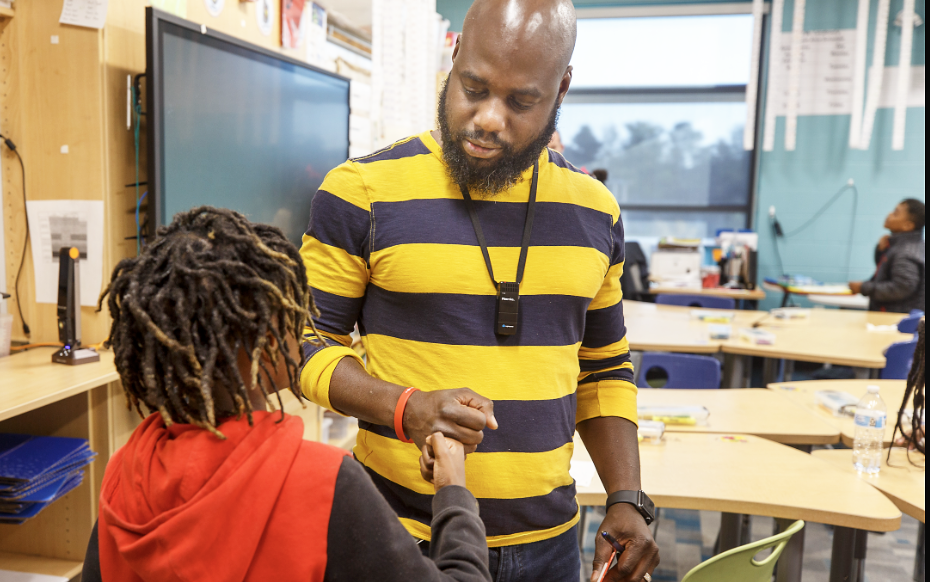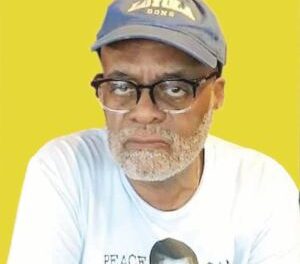By Devna Bose | The (Charleston) Post & Courier
This is an installment of the AL.com Education Lab’s “Tackling Teacher Shortages” series, produced in collaboration with newsrooms around the country.
By second period, word had gotten around: Mr. Thorne wasn’t coming back to teach next year.
What his students didn’t know was that Preston Thorne had been fighting a losing battle for years.
In 2017, Thorne’s last year as a high school teacher, he was one of just about 1,436 Black male teachers in South Carolina, or less than 3% of the total teacher workforce, according to the state’s Department of Education. Four years later, the percentage is unchanged.
The lack of Black male representation isn’t just a South Carolina problem.
Just 7% of America’s public school teachers were Black during the 2017-18 school year, while Black students make up 15% of the student population, according to the most recently available data from the National Center for Education Statistics.
It’s no secret that schools across the country have long struggled with their recruitment and retention. Since the COVID-19 pandemic, teachers of all demographic backgrounds have been leaving the field. Poor pay, increased public scrutiny, micromanagement and other issues exacerbated by the pandemic have increased vacancies nationwide. South Carolina has seen the highest number of educator vacancies this year since the Center for Educator Recruitment, Retention and Advancement started tracking the trend in 2001.
But these issues can have a greater impact on Black male teachers and other teachers of color, especially if they feel looked over for promotions and leadership opportunities, or pigeonholed into disciplinarian roles.
Their absence in classrooms is deeply felt, especially in states like South Carolina where almost a fifth of students are Black. Research shows that Black teachers can turn around young Black students’ lives, leading to improved academic performance and higher graduation rates.
While teacher vacancies are affecting all educators, experts say if South Carolina wants its Black students to succeed, it can’t afford to lose any more Black male leaders in the classroom.
The last straw
Thorne, a former University of South Carolina defensive lineman, ended his first year as an educator with no complaints.
He started teaching social studies at Blythewood High School in Richland 2 school district in 2005, the same year the school was founded.
“I was proud to be a part of a community,” he said. “That’s something that I always wanted to be in. I never really wanted to go from school to school.”
During his fourth year, Thorne started teaching an African American Studies course that he designed. It was his dream, and he began teaching the course a couple years before debates about teaching Black history and critical race theory swept the nation.
“For Black men in the classroom, there’s always a political awareness that people are watching you, especially when you’re teaching in a school with White children,” Thorne said.
Thorne’s administration and the Blythewood community was generally supportive, he said, and what followed were some of the most fulfilling years of his life. He was voted Blythewood High’s 2015-16 Teacher of the Year.
But by that point, Thorne had also started helping out with the football team as a coach. Early on during his time at Blythewood, he applied for the head coach position when it became available.
The first time he was turned down, he understood. But then it happened again — and again.
That last rejection in spring 2017 was the last straw for Thorne.
“The third time was devastating, because I knew I was at a point in my career where I knew that’s what I wanted to do,” he said. He decided to leave.
In an emailed statement, Lexington 2 district superintendent Brenda Hafner, Blythewood’s then-principal, said the school community was sad to see him leave, but she did not address why he didn’t get the position.
“Preston Thorne was a unique piece of what made our school culture so great,” she said. “His athletes loved him, but the student population in general was drawn to his eclectic being.”
Eric Duncan, part of education advocacy organization Ed Trust’s policy team, said Thorne’s story is one echoed by Black male educators nationwide who feel perpetually overlooked.
“You can kind of rationalize somebody’s frustrations if you feel a level of trust in the system, a level of trust in your school,” he said. “But it’s exacerbated when you have continually been overloaded, you continue being sort of devalued.”
It all comes to a head eventually, Duncan said.
“A person might say, ‘I’ll stick with this for a little while, if I get the job that I want,’” he said. “But when it doesn’t happen, it’s like, ‘All right, to heck with this. I’m not going to endure this any more.’”
Making a connection
Tyler Wright led one of his students into the hallway.
The student had just had another outburst, and Wright couldn’t watch him get written up again. Wright, then a student teacher at Stono Park Elementary School in Charleston, asked if he could take the student outside and try to talk to him.
Within minutes, the student started crying.
“He was telling me that he really doesn’t get to see his dad and stuff like that,” Wright said. “That his dad was supposed to come see him but never did. At the end of the day, that was the root cause for the outbursts, because the child was angry.”
Wright understood the student’s pain. Wright told him that he’d grown up in a similar situation, but he’d succeeded in school because he still paid attention the best he could, despite what was going on at home.
“And I let him know that I’m always here, that there’s always somebody to talk to,” he said.
That’s all it took, Wright said, for the student to finally open up and improve his behavior.
Black boys’ emotions and behavior are often misinterpreted by teachers, research shows. Nationally, Black boys are overassigned to special education — judged by teachers who don’t understand their behavior, or too quickly decide that their behavior is unusual instead of digging deeper. Then they’re put into isolated, self-contained classrooms, or disciplined frequently.
“The issue starts fairly young,” Duncan said. “They get negative impressions of school because they are traditionally overdisciplined or misidentified in terms of behavior challenges, when they may have some other issues or challenges that should be addressed in a more culturally proficient way.
“What’s the likelihood of them wanting to return back to that particular environment to become educators?”
When Black boys have Black teachers, there’s a higher likelihood that teacher and student can connect on a deeper level, and break cycles of stigma, experts have found.
Duncan said there are constant barriers to the teaching profession for Black men — many have families that can’t afford having a low-paying job. There are testing licensure requirements that, historically, were deliberately created to prevent people of color from becoming teachers.
South Carolina schools’ racial demographics of teachers show the impact of these obstacles to Black men entering the profession.
According to an analysis of state teacher workforce data by The Associated Press, the racial demographics of South Carolina teachers barely budged from 2016 until 2021.
Only around 40 Black male teachers, on net, joined the state workforce each year from the 2016-17 school year to 2020-21.
The only available data just tracks the gender and ethnicity of South Carolina’s teachers from year to year — no organization, including CERRA, tracks demographic turnover data.
‘An important investment’
Wright became a full-time teacher at Stono Park Elementary in January, thanks to a program in Charleston aimed at increasing the number of Black men in the classroom.
Men of CHS Teach is a partnership between the University of South Carolina and the Charleston County School District that makes the teaching profession more accessible to men of color. The program places its members in elementary classrooms even if they haven’t participated in a student teacher program, and creates an alternative pathway for them to get their teaching license.
CCSD decided to focus on recruiting elementary teachers because it’s typically difficult to fill those positions with men, and research shows that if Black students have a teacher of color in elementary school, they’re less likely to dropout of high school and more likely to consider college — for Black boys of low-income backgrounds, those effects are even greater.
Program organizers hope to hire 20 male teachers of color within the next five years.
Wright was one of the program’s first inductees. A few years later, Wright is leading a classroom of his own.
“The percentage of students who are potential teachers of color is getting smaller and smaller,” said April Butler, director of the program. “It’s an investment for the district to do this. And it’s an important investment.”
Charleston, York 3, Richland 1 and Aiken are the South Carolina school districts that have seen the greatest increase in the total number of Black male teachers in recent years, with a net total of almost 80 new hires from 2017 to 2021. However, they still have a very small share of Black male teachers overall.
The program in Charleston was partially inspired by Call Me MiSTER, another program aimed at recruiting minority male teachers.
Clemson University’s Call Me MiSTER program has been around for about two decades. The concept behind the program is recruiting, training and certifying minority men to become elementary school teachers in South Carolina.
Mark Joseph, the program’s director, said they’ve seen a decrease in applicants in recent years and have had to put more effort into recruitment. It’s a brand-new era of teaching after the pandemic, Joseph said, and so the program has had to be adjusted to meet that.
“We took a different approach in terms of talking about leadership, talking about college, talking about what it’s like being a part of a program that provides support, encouragement, brotherhood and teamwork,” he said.
One stark realization, he said, has been that teachers are ambassadors for the teaching profession.
After all, the teachers they’re looking to recruit aren’t coming out of thin air — they’re sitting in classrooms across South Carolina.
Preparing a new generation
Thorne also is still working to recruit minority teachers to the field in South Carolina.
He’s the director of the Apple Core Initiative at the University of South Carolina’s College of Education, which is designed to recruit students from underrepresented populations into teacher education programs at USC and deploy them in South Carolina classrooms.
“I didn’t leave the classroom frustrated,” he said. “I love teaching. And now I work with teachers going into the classrooms.”
Recruiting teachers is a calling, Thorne said. He spends day in and day out encouraging students of color to become teachers, and coaching them on how to navigate the unique challenges they might face — because he knows how badly South Carolina needs it.











